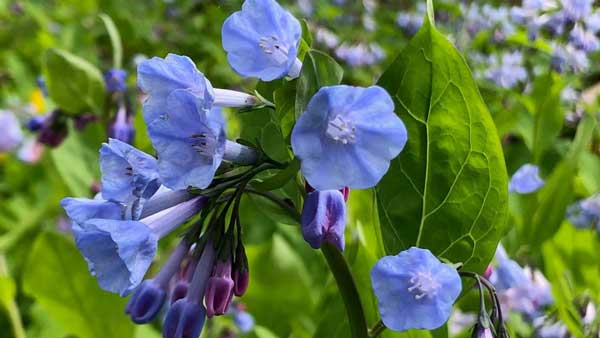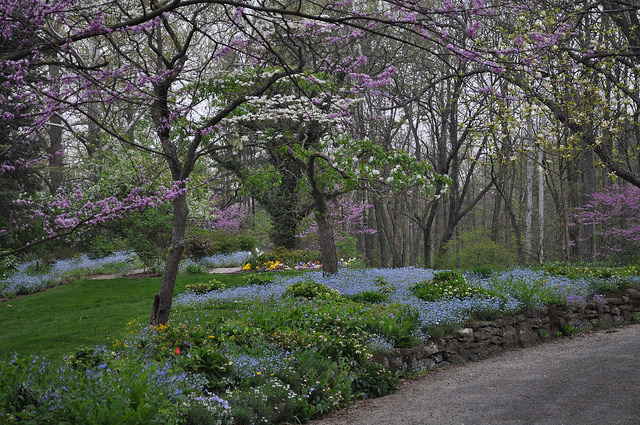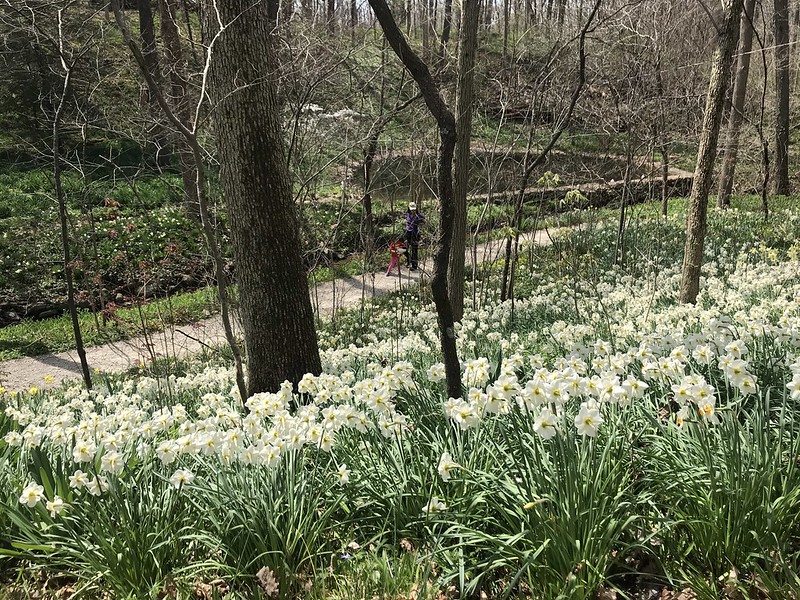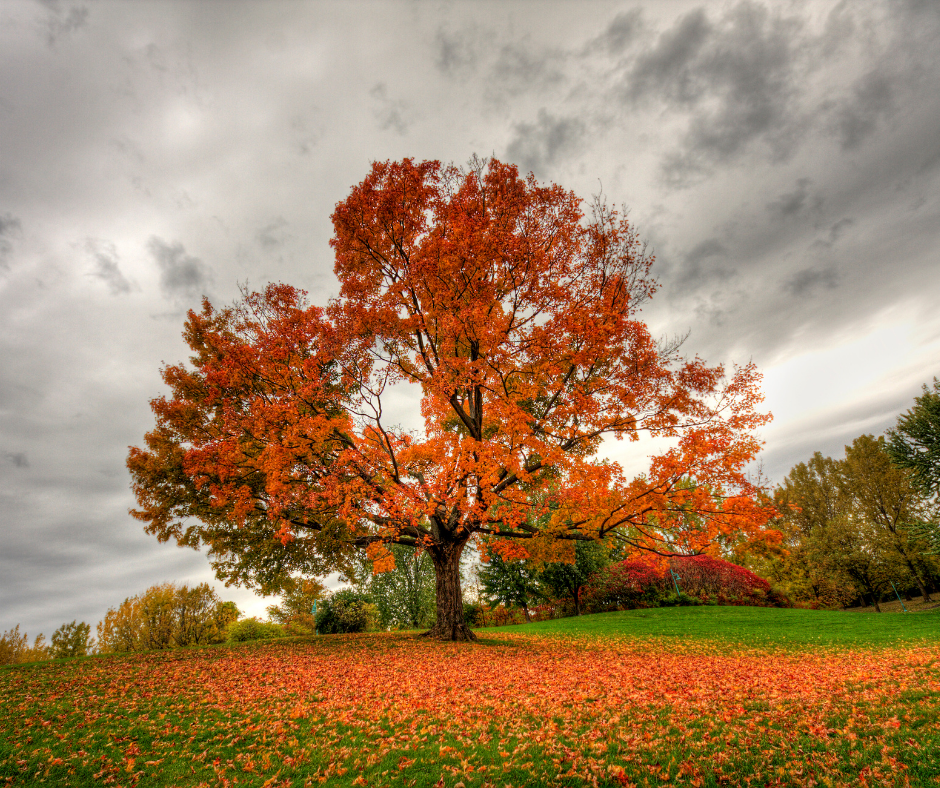Published April 18, 2023
April Gardening: Native Plant Sales, Aullwood Garden 100th Anniversary, and more
Heads up! This article was published 1 year ago.

Spring is here and what a spring it is! Plants emerging and/or blooming long before their normal time, extreme temperature fluctuation, and bright sunny days that tease us to go outside and start gardening now! The “new normal” of our changing climate also has implications for when to plant and how quickly plants will grow and mature. This is the perfect year to begin a garden journal—not just for spring, but for the whole year—noting temperatures and rainfall, what blooms when and the appearance of pollinators, the soil temperature, and the date of the last frost, as well as how plants did when planted at different times from usual. Many seed companies are now saying that our frost-free date is as early as April 25 or May 5, instead of our traditional May 15. So this will be a play-it-by-ear year for gardening, trying new dates as well as the traditional ones, and seeing how it goes.
Celebrating 100 Years at Aullwood Garden
Aullwood Garden is celebrating its 100-year anniversary in 2023 and with spring ephemerals and bluebells about to pop, it is a fantastic time to get out and appreciate the beauty of one of our local gems. Marie Aull, the former resident of the Aulwood home and a gardening and sustainability legend in the Miami Valley, including helping found MetroParks. The ocean of bluebells planted by the late Marie Aull in the wooded area around the property is speckled with anenome, dutchman’s breeches, celandine poppy, trout lily and other notable and lovely spring ephemerals. Around the home you’ll find deeply scented viburnum and magnolias and cheery daffodils. It is one of those places that is constantly changing through the season, making each visit a real joy. We hope you celebrate springtime at Aullwood as well as the many seasonal changes and the beautiful sights that can be seen at this wonderful park all year round.
Upcoming Gardening Events
Whether you are an experienced gardener or new to the scene, native plants are a beautiful and often fairly easy addition to the home garden and landscape. Not only are they beneficial in supporting local wildlife and insects, but they are a great way to entice pollinators to your vegetable garden and require less maintenance than many non-native annuals.
We often get questions about where you can source native plants in the area. In addition to checking your local garden center/nursery to see if they have a selection of native plants, we have some local plant sales coming up that can help you create the native wildflower habitat of your dreams!
- April 22, May 6, May 20: Native Plant Sale at Bowyer Farm (Cincinatti Zoo plant sale)
- April 28 & 29: Aullwood Audubon Native Plant Sale
- May 5: MayFair Plant Sale (includes natives and non-native perennials and annuals)
- May 7: Native Plant Sale at Second Street Market
For the Ornamental Garden
The key number is 50! Don’t cut back stems or pull away faded foliage from last year’s perennials until day and night temperatures are above 50 degrees. This gives pollinators time to hatch and get active. That being said, now is a busy time for all gardeners:
- Decide which perennials will need to be divided in May and what you will do with the extra plants
- Plan to add more natives this year
- Have compost ready to put down to feed the soil at planting time and as perennials emerge
- Prune back any winter damage on trees and shrubs
- WAIT to prune lilacs and other spring blooming shrubs until the last blossoms have fallen and then prune at that moment so you’re not cutting off next year’s blossoms
- Don’t remove foliage from spring bulbs until it has started to turn brown. Let emerging perennials cover the declining bulb foliage.
- Cut back roses (except for climbers) by mid-April and start fertilizing
- Use the composted leaves you saved last fall as great top dressing and edging in beds and around shrubs
- Plant summer flowering bulbs in late April, depending on the weather warm-up

Dandelion Flowers: A Fantastic Spring Edible
Greens, flowers, and roots: every part of the dandelion is edible and full of nutrients.
Find a patch of dandelions that are free of herbicide/pesticide sprays and try the recipe below to taste this abundant, flavorful, nutritious, and free food.
Recipe for Dandelion Fritters (makes about six)
- Combine:
- 1 cup dandelion heads (freshly picked and washed)
- 1/4 cup cornmeal
- 1/4 cup all purpose flour
- 1/4 teaspoon baking soda
- 1/4 teaspoon baking powder
- 1/2 teaspoon salt
- 1/2 teaspoon black pepper
- 1/2 teaspoon smoked paprika
- 1/2 cup water or almond milk
- Sauté onions and garlic until fragrant.
- Stir together dry ingredients in a bowl, and then add the sautéed onions, garlic, and water/almond milk, stirring until you get a thick batter. Form batter into 2-3 inch wide fritters.
- Fry in oil (coconut, olive, peanut, or vegetable oil should work fine) on medium heat until both sides are nicely browned and an have a crunchy outer coating.
- Serving suggestion: Eat warm, with sour cream, Dijon mustard, or butter on the top.
Volunteer Opportunity: Garden To-Go Kits
Are you interested in becoming a Five Rivers MetroParks Volunteer? We have many opportunities in gardening, program assistance, and garden outreach.
One of our featured opportunities helps us assemble our garden to-go kits: a major component of our garden outreach education. These kits contain 12 different kinds of plant seeds, seedlings, include information on how to grow a garden from start to finish and are a helpful tool for new gardeners as well as experienced gardeners. Kits volunteers help assemble are distributed free of charge to residents in our region who are living in food deserts or experiencing food insecurity. Visit our Get Connected platform for this opportunity and many more like it.
An initiative of the Growing for Good program, presented by Dayton Children’s, Garden to-go kits would not be possible without the hard work of our dedicated volunteers.







